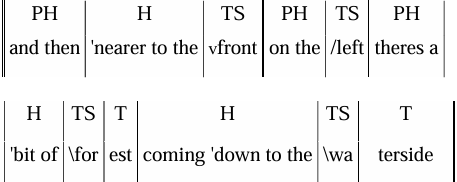
The tail
 المؤلف:
Peter Roach
المؤلف:
Peter Roach
 المصدر:
English Phonetics and Phonology A practical course
المصدر:
English Phonetics and Phonology A practical course
 الجزء والصفحة:
142-16
الجزء والصفحة:
142-16
 2024-11-07
2024-11-07
 1303
1303
The tail
It often happens that some syllables follow the tonic syllable. Any syllables between the tonic syllable and the end of the tone-unit are called the tail. In the following exam ples, each tone-unit consists of an initial tonic syllable and a tail:
look at it /what did you say �oth of them were here
When it is necessary to mark stress in a tail, we will use a special symbol, a raised dot • for reasons that will be explained later. The above examples should, then, be transcribed as follows:
look at it /what did you -say �oth of them were -here
This completes the list of tone-unit components. If we use brackets to indicate optional components (i.e. components which may be present or may be absent), we can summarize tone-unit structure as follows:
(pre-head) (head) tonic syllable (tail)
or, more briefly, as:
(PH) (H) TS (T)
To illustrate this more fully, let us consider the following passage, which is transcribed from a recording of spontaneous speech (the speaker is describing a picture). When we analyze longer stretches of speech, it is necessary to mark the places where tone-unit boundaries occur - that is, where one tone-unit ends and another begins, or where a tone- unit ends and is followed by a pause, or where a tone-unit begins following a pause. It was mentioned above that tone-units are sometimes separated by silent pauses and sometimes not; pause-type boundaries can be marked by double vertical lines (II) and non-pause boundaries with a single vertical line (I). In practice it is not usually important to mark pauses at the beginning and end of a passage, though this is done here for completeness. The boundaries within a passage are much more important.
|| and then 'nearer to the vfront || on the /left | theres a 'bit of forest | 'coming
'down to the waterside || and then a 'bit of a /bay ||
We can mark their structure as follows (using dotted lines to show divisions between tone- unit components, though this is only done for this particular example):


The above passage contains five tone-units. Notice that in the third tone-unit, since it is the syllable rather than the word that carries the tone, it is necessary to divide the word 'forest' into two parts, 'for-' fɒr and ' est' ɪst; in the fourth tone-unit the word 'waterside' is divided into 'wa-' wɔ: (the tonic syllable) and '-terside' təsaɪd (tail). This example shows clearly how the units of phonological analysis can sometimes be seen to differ from those of grammatical analysis.
 الاكثر قراءة في Phonetics and Phonology
الاكثر قراءة في Phonetics and Phonology
 اخر الاخبار
اخر الاخبار
اخبار العتبة العباسية المقدسة


